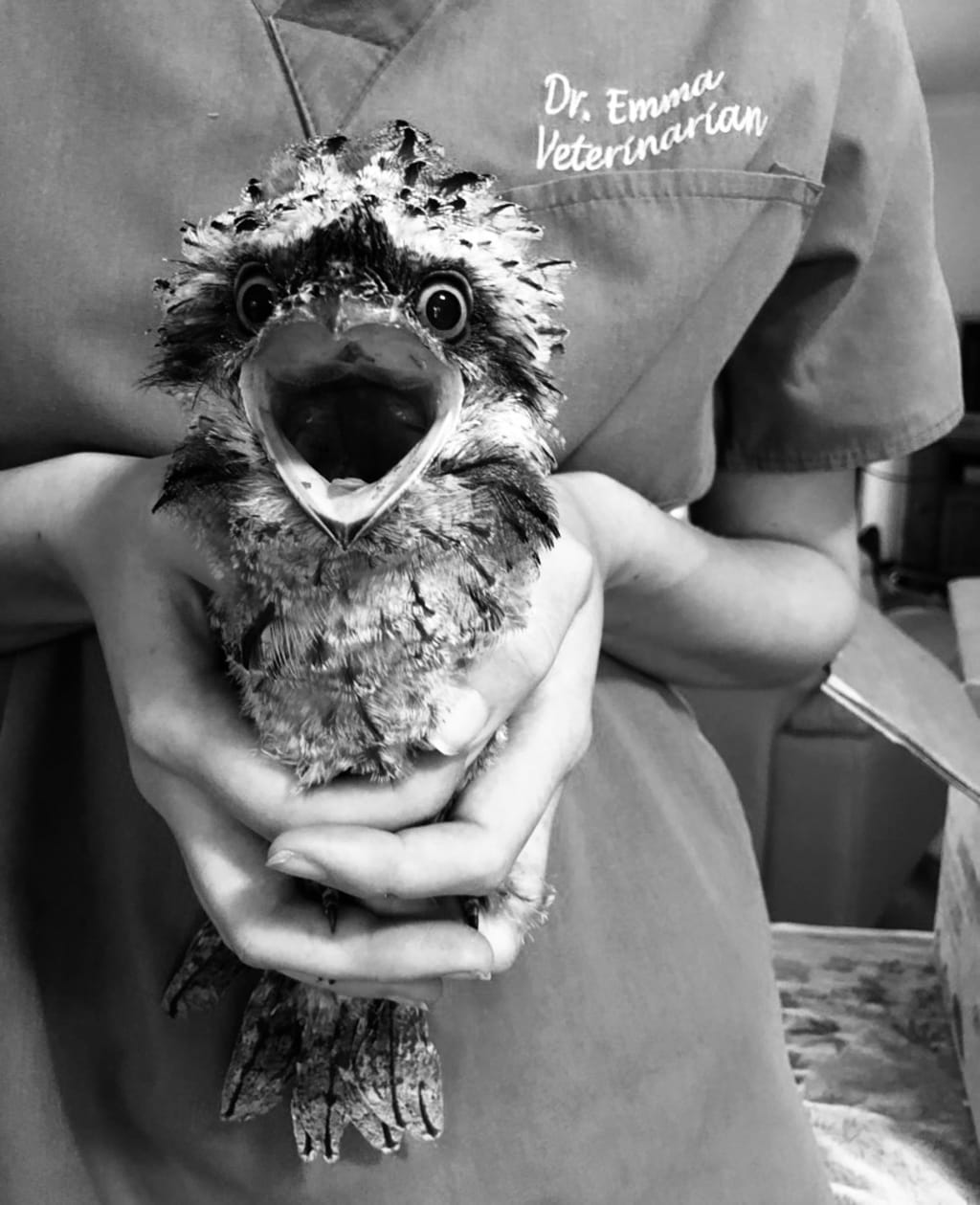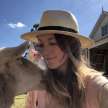
The first time was in my grandparents’ garden. On a somnolent late spring night my grandfather took me to see them, walking me by the hand along the red concrete path that I remember now for its tendency to tattoo the soles of bare feet with its colour; my grandmother scrubbing my feet in the bathtub, lest the carpet bear a permanent reminder of the day’s hunt for lizards or woodlice.
The boundary to my grandparents’ property was indistinct, melding with the garden next door, which belonged to a lady named Marge, who had long since melded her own life with Nana and Grandad’s. As her fat ginger cat came and went from Marge’s house, so did Marge in my grandparents’ home. At the point where a fence might have separated the neighbours there was instead a mulberry tree of grand proportions, prosperous production and inscrutable ownership. It was in this tree that I met my first tawny frogmouths. A family of four, golden yellow mouths open to receive bacon rind proffered by bare fingers, still naïve to the feeling of the mousetrap-like beak closing on a joint or a cuticle. I was entranced, and from that night onward would beg to be allowed to visit my grandfather’s special pets, always borne by the mulberry tree, disguising themselves so convincingly as extra limbs, until the glint of an amber eye or the widening of a yellow grin gave them away. Late into the night I would lie awake in the bed where my mother used to sleep, listening for their ‘mopoke’ call.
The call gives the tawnies their Mopoke name. In common usage, a tawny frogmouth is a mopoke, and a mopoke is a tawny frogmouth. But they are not owls. This misconception is tremendously common, and (possibly only due to a tendency towards a Type A personality) I find it as frustrating now, as a wildlife veterinarian and rehabilitator, as I did as a small child. ‘How can you appreciate something that you don’t understand?’ I once thought. ‘Then help people to understand.’ I think now, ‘The appreciation will follow’. The tawny frogmouth is not an owl. But they are every bit as fascinating.

Though the Hogwarts gig might be out of their reach, the resume of a tawny frogmouth would bear a lot of similarities to the owls they are mistaken for. Like owls, tawnies are nocturnal hunters of rodents and insects. They boast specialised sensory feathers around the face, which aid them in detecting their prey. They can lay a claim to that supposed wisdom of owls, too. Who wouldn’t concede that employing top quality camouflage to avoid unwanted attention is a wise tactic (or be tempted to use the same upon encountering an odious acquaintance in the wilds of the supermarket)? Tawnies doze through the day, secure in the knowledge that to even the keenest eye they appear, at first glance, to be a part of the tree they’re in.
One of the largest points of difference between a tawny and an owl is the feet. Owls are raptors. They lead an attack with their talons- strong vices, nails sometimes an inch long and sharp as a knife, closing with literal break-neck speed on their prey and vets’ fingers alike. Tawnies on the other hand… well, at the risk of sounding like a huge nerd, I think it’s best portrayed by their Latin name. Podargus- it comes from the word that means ‘gout’, specifically because of their weak little feet and the way they toddle on them when walking, as if they can barely bear the weight of the animal they support. It may sound dull, but I promise there’s a lot of fun to be had in understanding the Latin names of the animals around us. But perhaps only a particularly geeky veterinarian would say that…

In my veterinary career tawny frogmouths have been prominent. Knowing even the little that you do about my childhood, it probably comes as no surprise that I have always been passionate about birds and wildlife. Throughout my veterinary training I took every opportunity to indulge my ornithological bent and further my education in these areas, gaining placements in wildlife hospitals and shadowing at avian clinics. I must have seemed to those vets much like a baby bird myself, begging for knowledge like a chick in the nest begs for food. “And can I perch on your shoulder…er … watch over it while you do this surgery?”
As a newly fledged vet, working in a clinic with a high wildlife caseload and an excellent boss who allowed me free reign for treating these cases (at cost to the clinic in private practice in Australia), my first wildlife case was a tawny. He was a large male, a road trauma case, and I remember him particularly well because of one trait I have yet to mention that sets tawnies apart from owls: defensive defecation. When they feel threatened, tawnies can produce at will a steaming torrent of foul smelling liquid waste, which propels from them at such force that anything pursuing them will be stopped in their tracks upon receiving a face-full. Following examination and flight test of this tawny I was able to determine that 1) he was not badly injured, and 2) I was perceived a threat. By 9am on my second day as a veterinarian my own scrub top was befouled and I was wearing something from the store cupboard spruiking the latest tick treatment. But I wouldn’t hold a grudge. With a couple of days of treatment Mr Tawny was ready for release back to his home territory, and I had once again entered into a love affair with this particular species- the first of dozens of tawnies that I have treated and rehabilitated to date.
I have worked with the media on a few occasions on wildlife-related stories. Each time I have been interviewed I have been asked why I have a passion for working with wildlife. The reason is this: that almost every reason these animals present to me in a veterinary setting is a manmade problem. Car strikes, attacks by cats and dogs, damage from barbed wire fences. Even many of the ‘orphans’ we see each year enter care due to human error. So don’t we owe these animals their treatment?
1. The Car Strike

They come to me with hyphaema- bleeding into the chambers of the eye, those beautiful amber orbs so vulnerable to blunt trauma. They come gasping, the pink membranes in the backs of their mouths bluing as they struggle to respire with the airsacs they require to breathe ruptured by the force of collision. These structures, so finely built with a texture and appearance like gladwrap, popped like a balloon, the air sometimes pocketing under the skin- I can feel it during my examination, this bubblewrap texture. I hate it. There are broken bones, there are lacerations. I do my best to fix what I can.
2. The Barbed Wire Victim

Sometimes they come with barbed wire still attached- their rescuers, wildlife carers or members of the public, unable to disentangle a screaming, thrashing bird and cutting the strands in desperation. Under anaesthetic and my surgical light, the tissue tells the story of the struggle to escape- they twisted and turned, again they somersaulted, their skin unreleasable from the brutal dentition of the wire. Pierced, stretched, torn. Eventually they may have grown still. Exhaustion and dehydration. Perhaps it was days before rescue came.
3. The ‘Orphan’

In some ways happier. There is nothing cuter than a baby tawny frogmouth, and I will fight you on that statement. But always the question upon seeing the bobbing head, mouth opening, alert to the promise of food: ‘Do you need to be here?’ Another fact about tawny frogmouths: they are terrible engineers. Their nests are a loose platform of a few sticks (if any) in the forked branch of a tall gumtree. Is it any wonder that a light breeze can see a baby on the ground? I have heard a theory that the regularity of this event is probably due to the fact that there are fewer huge and old gumtrees on offer today, limiting their choice in breeding site to more flimsy locations. I choose to believe this, in the spirt of being charitable. This is why the nestlings arrive at the clinic. The next life stages in the growth of a tawny chick are the branchling and the fledgling. At these points the chick is out of the nest, sitting on sometimes low branches with mum and dad watching over from either the same or a nearby tree. Very frequently these babies are misidentified as being lost- especially since the parents are often so well camouflaged in their positions. This is exacerbated by the tendency of even adult tawnies to freeze in position as soon as the sun comes up, whether in a tree or whether they accidentally happen to be on the ground when this occurs (a fourth category of hospital admissions that I could call ‘The Late Night Partier’: an easy treatment). The result is that members of the public, incredibly well-meaning, present these tawnies into the clinic assuming them to be ailing or displaced from the nest. This brings me to the two options for handling the case of the ‘orphan’:
3a) Operation Reunion
Having examined the baby and satisfied myself that they are not injured, I am often able to perform what I always think of as a little miracle. For a window of a few days after a baby is taken, the parents may continue to recognise it and accept it back. So begins Operation Reunion. Under cover of night, having performed enough reconnaissance to know the most exact details about the location in which the baby was found, I return to la scène du crime. What I do next depends on the size of the baby. A very small baby can be place in a bucket nest- a bucket rigged up to safely contain the baby, protected from the weather, positioned in a tree. In the case of a branchling or a nestling, I will usually set them up on a low branch of a tree- ideally the one they came from. And then, I wait.
From a safe distance I will deem Operation Reunion a success if I can determine that the parents have found the baby, and fed it.
3b) I’m Your Mother Now
Though it is the best case scenario, sometimes Operation Reunion is a mission doomed. Sometimes it’s simply not possible, due to injury of the baby, lack of details on location found or an inappropriate site of release. In this case, the baby will need to be raised artificially. This presents its own set of issues. The transformation of an adorable living pompom into a healthy, well-adjusted, behaviourally equipped nocturnal hunter is an act of parenting that we as humans are poorly equipped for. One way we can mitigate developmental disaster is to group babies together to raise. Phone calls are exchanged between the local carers, the absurd trading system of baby tawnies during the busiest season for wildlife in general. “Yes, but only two” “No, none” “No, but I know someone with six, let me get you a number”. Tawnies are accepting, even as adults. They bond quickly and easily with the individuals they are in care with. Chicks at slightly different stages will lay down lessons in tawniness that will be picked up by the babies around them in the same way as they pluck wriggling mealworms from the feeding forceps.

This brings me to the next challenge of frogmouth foster care: food. We try to expose the chicks to an array of foods that they will encounter in the wild, in the hopes of sparking recognition as a prey item scurries by. After all, doesn’t every parent worry about their children feeding themselves well once they move out of home? To this end we put ourselves through what is to some a traumatic experience.
Pink baby mice, who unfurl, limbs twitching in hot water as they thaw, almost reanimated. All manner of insects, bought in tubs from the pet store. Born and sold to die. These things make me sad, but without the education the tawny babies will not survive long term, so I avoid the temptation to feed only the easy alternative of an Insectivore supplement with meat. This is a good basis for a diet, but unlikely to be found climbing the limbs of a Eucalyptus, or drawn to the halo of a streetlight.
And then, release. I favour a soft release approach. The young tawnies are housed in an aviary at their release site, eventually for the door to be opened. Freedom attained. But, it needn’t be immediate. The door will remain open for tawnies seeking shelter during the day in their first weeks. Supplementary food will be on offer. They will require these things less and less as their confidence grows.

One of my great joys comes from a pair soft-released on my own property several years ago, who have remained and each year present us with a brood of their own chicks. The only support they require now, emotional. Validation. “Look what we have achieved", I hear them call as I lie awake on a late spring evening. Or perhaps they don’t say that at all. Perhaps they are only saying ‘mopoke’.
No, the tawny frogmouth is not an owl. But it is every bit as fascinating. Don’t you agree?






Comments
There are no comments for this story
Be the first to respond and start the conversation.